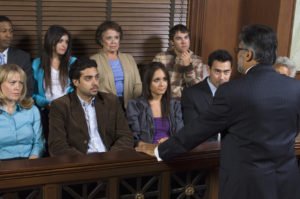
Yes, Nevada trial attorneys may dismiss potential jurors from the jury pool for cause if the potential juror exhibits actual or implied bias. And if a trial attorney merely suspects the potential juror is biased, the attorney may be able to dismiss him/her without giving a reason through a peremptory challenge.
How does jury selection work in Nevada criminal cases?
The jury selection process is called voir dire. This is when the prosecutor and defense attorney question the members of the jury pool, called the venire. Voir dire takes place in the courtroom, with the potential jurors usually sitting in the jury box.
The questions that the attorneys pose to the venire are meant to suss out whether a particular person would be a competent, fair and impartial juror. In a rape case for example, the attorneys may question the venire about whether any of them have been sexual assault victims. And if so, would they be able to put aside their emotions and judge the defendant based on the facts of the case.
Attorneys also ask whether anyone in the venire has pre-existing knowledge about the case to be tried. In highly-publicized cases, it may be difficult to find people who have not heard about it. So then the attorneys try to determine whether they would be able to ignore everything they heard and render a verdict based solely on the evidence presented to them.
Voir dire typically lasts one day, but it can go longer.
How do attorneys dismiss potential jurors?
There are two ways that attorneys can dismiss juror candidates from the venire: 1) Challenges for cause, and 2) peremptory challenges.
Challenges for cause
Lawyers make challenges for cause when they believe a particular venire member is not suitable to serve. This can occur when a person explicitly states that he/she is biased, such as by declaring he/she would never convict a defendant due to religious reasons. Another example of explicit bias is when a person declares that the defendant is probably guilty because most people who get arrested did something wrong.
Venire members can also be dismissed for cause if they show implicit bias. For example if the defendant is a law enforcement officer on trial for police brutality, the prosecuting attorney may try to challenge for cause any venire members who are police officers on the theory that they would hold fast to the “blue wall” and never convict a fellow officer.
The defense attorneys and prosecutors take turns in front of the judge arguing challenges for cause. The judge has to grant each challenge for cause. (This process is called “striking the jury”.) There is no limit to the number of challenges for cause an attorney can make.1
Peremptory challenges
Peremptory challenges allow attorneys to dismiss potential jurors without giving a reason. This is a way attorneys can dismiss people that they believe will not go their way, even if they claim that they would be fair. However, it is illegal to dismiss venire members just based on their race or gender.
The prosecution and defense team are typically limited to four peremptory challenges each in Nevada.2

Call our law firm for legal advice. We offer free consultations.
Legal References
- NRS 16.050; NRS 16.060.
- NRS 16.040; Batson v. Kentucky, (1986) 476 U.S. 79; JEB v. Alabama ex rel. TB, (1994) 511 US 127; see also Boonsang Jitnan v. Oliver, (2011) 127 Nev. 424, 254 P.3d 623, 127 Nev. Adv. Rep. 35.


